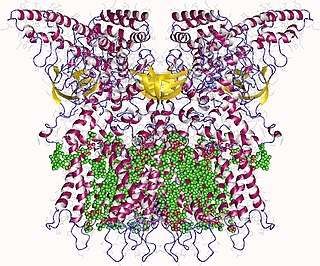Transient receptor potential channels are a group of ion channels located mostly on the plasma membrane of numerous animal cell types. Most of these are grouped into two broad groups: Group 1 includes TRPC, TRPV, TRPVL, TRPM, TRPS, TRPN, and TRPA. Group 2 consists of TRPP and TRPML. Other less-well categorized TRP channels exist, including yeast channels and a number of Group 1 and Group 2 channels present in non-animals. Many of these channels mediate a variety of sensations such as pain, temperature, different kinds of tastes, pressure, and vision. In the body, some TRP channels are thought to behave like microscopic thermometers and used in animals to sense hot or cold. Some TRP channels are activated by molecules found in spices like garlic (allicin), chili pepper (capsaicin), wasabi ; others are activated by menthol, camphor, peppermint, and cooling agents; yet others are activated by molecules found in cannabis or stevia. Some act as sensors of osmotic pressure, volume, stretch, and vibration. Most of the channels are activated or inhibited by signaling lipids and contribute to a family of lipid-gated ion channels.

Hesperetin is the 4'-methoxy derivative of eriodictyol, a flavanone. Hesperetin's 7-O-glycoside, hesperidin, is a naturally occurring flavanon-glycoside, the main flavonoid in lemons and sweet oranges. Hesperetin are not found to a significant extent in Citrus spp.

The inorganic dye ammoniated ruthenium oxychloride, also known as ruthenium red, is used in histology to stain aldehyde fixed mucopolysaccharides.

TRPV is a family of transient receptor potential cation channels in animals. All TRPVs are highly calcium selective.
TRPM is a family of transient receptor potential ion channels. Functional TRPM channels are believed to form tetramers. The TRPM family consists of eight different channels, TRPM1–TRPM8.

Transient receptor potential cation channel subfamily M member 1 is a protein that in humans is encoded by the TRPM1 gene.

Transient receptor potential cation channel, subfamily M, member 2, also known as TRPM2, is a protein that in humans is encoded by the TRPM2 gene.

Transient receptor potential cation channel subfamily M member 5 (TRPM5), also known as long transient receptor potential channel 5 is a protein that in humans is encoded by the TRPM5 gene.

Transient receptor potential cation channel subfamily M member 4 (hTRPM4), also known as melastatin-4, is a protein that in humans is encoded by the TRPM4 gene.

Transient receptor potential cation channel subfamily V member 4 is an ion channel protein that in humans is encoded by the TRPV4 gene.

Transient receptor potential cation channel subfamily M (melastatin) member 8 (TRPM8), also known as the cold and menthol receptor 1 (CMR1), is a protein that in humans is encoded by the TRPM8 gene. The TRPM8 channel is the primary molecular transducer of cold somatosensation in humans. In addition, mints can desensitize a region through the activation of TRPM8 receptors.

Transient receptor potential cation channel subfamily M member 3 is a protein that in humans is encoded by the TRPM3 gene.

Transient receptor potential cation channel, subfamily V, member 3, also known as TRPV3, is a human gene encoding the protein of the same name.

Transient receptor potential cation channel, subfamily M, member 7, also known as TRPM7, is a human gene encoding a protein of the same name.
Treatment of chronic fatigue syndrome (CFS) is variable and uncertain, and the condition is primarily managed rather than cured.

Clinical descriptions of chronic fatigue syndrome (CFS) vary. Different groups have produced sets of diagnostic criteria that share many similarities. The biggest differences between criteria are whether post-exertional malaise (PEM) is required, and the number of symptoms needed. Aspects of the condition are controversial, with disagreements over etiology, pathophysiology, treatment and naming between medical practitioners, researchers, patients and advocacy groups. Furthermore, diagnosing CFS can be difficult due to several factors, including lack of a standard test and non-specific symptoms. Subgroup analysis suggests that, depending on the applied definition, CFS may represent a variety of conditions rather than a single disease entity.

Isosakuranetin, an O-methylated flavonoid, is the 4'-methoxy derivative of naringenin, a flavanone. Didymin, a disaccharide of isosakuranetin, occur e.g. in sweet orange, blood orange and mandarin. Isosakuranetin is a potent inhibitor of TRPM3 channels.

Chronic fatigue syndrome (CFS), also called myalgic encephalomyelitis (ME) or ME/CFS, is a complex, debilitating, long-term medical condition. The causes and mechanisms of the disease are not fully understood. Distinguishing core symptoms are lengthy exacerbations or flare-ups of the illness following ordinary minor physical or mental activity, known as post-exertional malaise (PEM); greatly diminished capacity to accomplish tasks that were routine before the illness; and sleep disturbances. Orthostatic intolerance and cognitive dysfunction are also diagnostic. Frequently and variably, other common symptoms occur involving numerous body systems, and chronic pain is common. The unexplained and often incapacitating fatigue in CFS is different from that caused by normal strenuous ongoing exertion, is not significantly relieved by rest, and is not due to a previous medical condition. Diagnosis is based on the person's symptoms because no confirmed diagnostic test is available.

Post-exertional malaise (PEM) is a worsening of chronic fatigue syndrome symptoms that occurs after exertion. PEM involves increased fatigue, and an exacerbation of other symptoms. PEM is often severe enough to be disabling, and is triggered by ordinary activities that healthy people tolerate. Post-exertional malaise typically begins 12–48 hours after the activity that triggers it, and lasts for days, but this is highly variable. Management of PEM is symptomatic, and patients are recommended to pace their activities to avoid triggering PEM.

CIM-0216 is a chemical compound which acts as a potent and selective activator of the TRPM3 calcium channel. It produces nociception and inflammation and is used to study the function of the TRPM3 receptor in these processes.
















